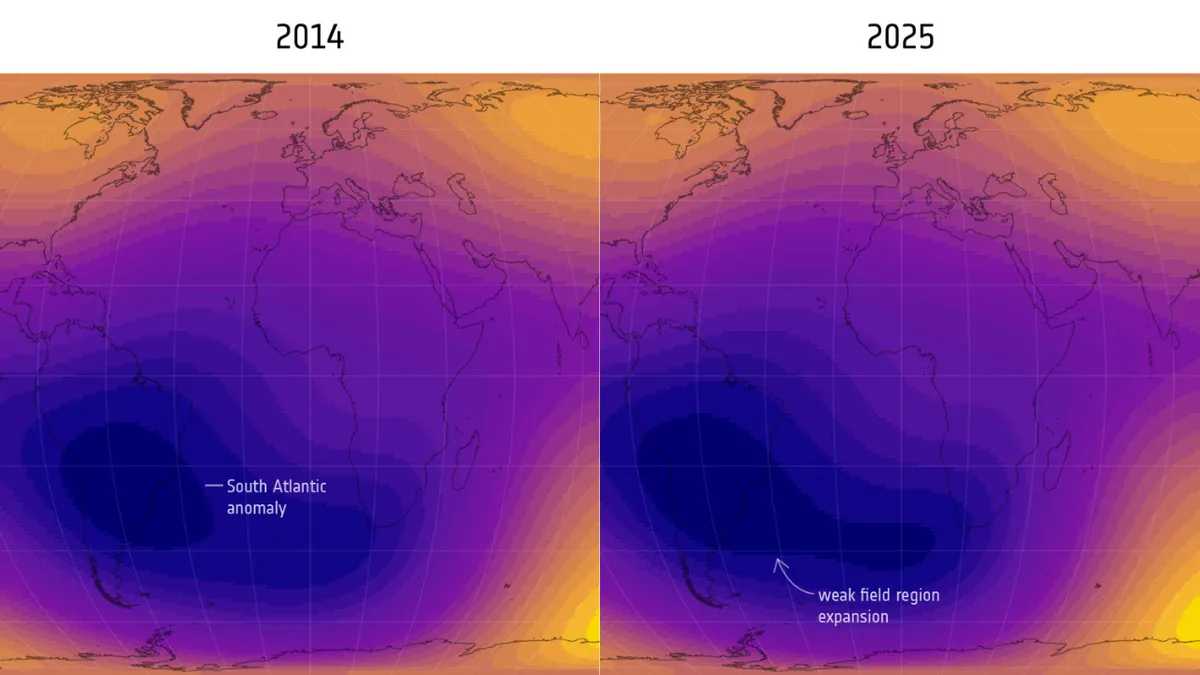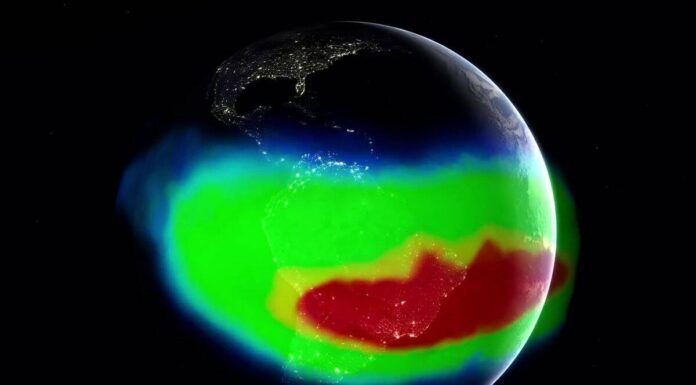Introduction
The South Atlantic Anomaly represents one of the most intriguing geophysical phenomena of our time, where Earth’s protective magnetic field dips to unusually low strengths over a massive area of about five million square kilometers. First noted in the 19th century, the SAA has accelerated its changes in recent years, driven by complex processes in the planet’s core. According to ESA’s Swarm satellite data, the anomaly is not just weakening but expanding and morphing, with a new lobe extending toward Africa {3}[G1]. This evolution raises questions about satellite safety, global magnetic stability, and potential long-term implications for life on Earth. While some speculate ties to a geomagnetic reversal, experts maintain it’s a natural variation, not an imminent catastrophe [G4][G2]. This article draws on factual data from recent studies and integrates expert perspectives to explore the anomaly’s dynamics, impacts, and forward-looking strategies.
The Science Behind the Weakening Magnetic Field
At the heart of the SAA lies a dramatic drop in magnetic intensity, from around 24,000 nanoteslas in 1970 to 22,000 by 2020, as reported in studies from Futurism and LiveScience {1}{2}.

This weakening allows the inner Van Allen radiation belt to approach Earth’s surface more closely, increasing radiation exposure in the region {5}[G7]. Satellite observations, particularly from ESA’s Swarm constellation launched in 2013, show the anomaly shifting westward at about 20 km per year and expanding rapidly—by an area equivalent to half of continental Europe since 2014 {3}[G1].
Recent research, including a 2024 study in Physics of the Earth and Planetary Interiors, reveals the SAA is not a uniform weak spot but a complex patchwork of “reverse flux patches,” where magnetic field lines invert and dive back into the core, reducing surface strength {1}{3}. These patches are most intense southwest of Africa, indicating accelerated weakening since 2020 {3}[G2]. Experts link this to heterogeneities at the core-mantle boundary and inner core contrasts, creating asymmetries between the Atlantic and Pacific regions [G3][G8]. As Universe Today notes, such dynamics reflect the geodynamo’s natural agitation, not necessarily a prelude to disaster {3}.
Impacts on Satellites and Technology
The SAA’s growth poses tangible threats to space infrastructure. Satellites passing through this zone face heightened radiation, leading to hardware failures, data blackouts, and instrument shutdowns—issues that have affected missions like the Hubble Space Telescope {5}[G5]. The Debrief highlights how the anomaly’s expansion, including a new lobe toward Africa, amplifies these risks for low-Earth orbit operations {5}[G10]. With the anomaly covering five million square kilometers and drifting westward, operators must now contend with unpredictable radiation spikes {1}[G7].
News from 2024 and 2025 underscores these concerns: ESA reports confirm uneven weakening, with the African lobe intensifying, potentially disrupting navigation and communication satellites {2}{3}[G8].

Popular Mechanics describes it as a “weird glitch” persisting for eight million years, now worsening and challenging mega-constellations like Starlink {4}[G4]. However, not all views are alarmist; Russian experts from IKI RAS, cited in Izvestia, argue the weakening is predictable due to Earth’s offset magnetic dipole and poses no immediate surface-level danger [G10][G13].
Debates on Geomagnetic Reversals and Broader Implications
A key debate centers on whether the SAA signals an impending geomagnetic reversal, last occurring 780,000 years ago. Some studies suggest reversed flux patches could be precursors to excursions or full pole flips, unfolding over millennia {7}[G2]. Frontiers research posits the anomaly as a symptom of broader core processes, potentially tied to global field decline of 5-10% over two centuries {7}[G1].
Countering this, experts like those from ESA and NASA emphasize caution: current behavior aligns with natural variability, not an imminent inversion [G4][G3]. ScienceAlert notes that while the SAA contributes to overall weakening, reversals are unpredictable and span thousands of years, dismissing hype about short-term catastrophe {7}[G2]. Social media discussions reflect this mix, with users sharing ESA visuals and debating risks, but experts counter alarmism by highlighting the anomaly’s role as a “natural laboratory” for core studies [G15]–[G20]. Balanced views stress that surface impacts remain minimal, with no visible effects on daily life [G7].
Constructive Perspectives and Solutions
Amid challenges, innovative solutions are emerging. ESA’s Swarm mission, enhanced by a 2018 Canadian satellite, provides real-time data for improved magnetic modeling and radiation predictions {3}[G1]. This enables “SAA-aware” orbital planning, where satellites adjust paths or power down during passes to mitigate damage {5}[G5].
Technological advancements include radiation-hardened electronics and enhanced shielding, as detailed in The Debrief {5}. Researchers advocate for AI-integrated models to forecast changes, potentially reducing disruptions for future missions [G8][G11]. On a broader scale, interdisciplinary studies blending geophysics and paleomagnetism could refine reversal predictions, while public awareness—fueled by social media trends—may boost funding for successors to Swarm [G19].
Experts like those from Knowridge call for proactive monitoring, viewing the SAA as an opportunity to advance space weather forecasting and protect critical infrastructure [G8]. By addressing these risks head-on, humanity can turn a geophysical curiosity into a catalyst for technological resilience.
KEY FIGURES
- The South Atlantic Anomaly (SAA) minimum magnetic field intensity dropped from about 24,000 nanoteslas in 1970 to around 22,000 nanoteslas by 2020 (Source: Futurism, Livescience) {1}{2}.
- The SAA covers a vast area roughly equivalent to five million square kilometers, expanding rapidly in recent years by an area nearly half the size of continental Europe since 2014 (Source: Futurism, Livescience, ESA) {1}{2}{3}.
- The anomaly is shifting westward at about 20 km per year (Source: ESA Swarm data, Futurism) {1}{3}.
- Since around 2020, an accelerated weakening has been detected southwest of Africa, indicating intensified changes in the SAA’s strength and shape (Source: ESA, Universe Today) {3}.
- The inner Van Allen radiation belt dips closer to the Earth’s surface in the SAA region, increasing radiation exposure for satellites flying through this zone, raising risks of hardware failures and data blackouts (Source: Universe Today, The Debrief) {3}{5}.
RECENT NEWS
- (2024) ESA’s Swarm satellite constellation reports continued and accelerated growth of the SAA, with distinct regional differences in weakening between areas near South America and Africa, highlighting complex geodynamic activity at the core-mantle boundary (Source: Futurism, Universe Today) {1}{3}.
- (2024) New maps from satellite data show the SAA expanding and developing a lobe towards Africa, where the weakening is most intense, leading to increased concern for satellite operators passing through this region (Source: Livescience, The Debrief) {2}{5}.
- (2025) Scientific articles emphasize the SAA as a dynamic and evolving feature rather than a simple dipole weakening, with studies suggesting it reflects broader inner core and outer core processes rather than an immediate precursor to a geomagnetic reversal (Source: ScienceAlert, Frontiers) {7}.
STUDIES AND REPORTS
- A 2024 study published in Physics of the Earth and Planetary Interiors shows the SAA is not a single block but a complex set of patches, with some areas weakening faster near Africa, linked to reverse flux patches where magnetic field lines dive back into the core, reducing surface intensity (Source: Futurism, ESA Swarm data) {1}{3}.
- Research indicates the SAA’s evolution is driven by heterogeneities in the core-mantle boundary and inner core contrasts, causing regional asymmetries in field strength between the Atlantic and Pacific sectors (Source: ESA, Frontiers) {3}{7}.
- Some scientific discussions propose the SAA might be a symptom of a geomagnetic excursion or prelude to a reversal, but robust counter-analyses maintain that the current global field behavior does not confirm an imminent inversion, emphasizing that reversals typically unfold over thousands of years and remain unpredictable (Source: Frontiers, PMC) {7}.
- Satellite data confirm the SAA has been tracked systematically only since the 21st century, with Swarm satellites providing unprecedented resolution of the anomaly’s shape, movement, and internal dynamics (Source: ESA, Universe Today) {3}.
TECHNOLOGICAL DEVELOPMENTS
- ESA’s Swarm constellation — launched in 2013 with three satellites and supplemented by a Canadian Space Agency satellite in 2018 — continues to provide critical real-time measurements of Earth’s magnetic field variations, including detailed monitoring of the SAA’s growth and spatial shifts (Source: ESA, Universe Today) {3}.
- Ongoing improvements in magnetic field modeling based on Swarm data support better prediction and mitigation strategies for satellite operators to cope with increased radiation exposure in the SAA region (Source: Futurism, ESA) {1}{3}.
- Enhanced satellite shielding and operational protocols are being developed to reduce hardware malfunctions caused by the elevated radiation in the SAA zone, addressing challenges faced by spacecraft during passage through this region (Source: The Debrief) {5}.
MAIN SOURCES
- https://futurism.com/science-energy/mysterious-weak-spot-earth-magnetic-field-growing – Article on rapid growth and complex behavior of the SAA, including satellite data analysis.
- https://www.livescience.com/planet-earth/a-massive-weak-spot-in-earths-magnetic-field-is-growing-scientists-discover – Coverage of SAA expansion and implications for satellites.
- https://www.universetoday.com/articles/esas-swarm-constellation-sees-growth-in-the-magnetic-fields-weak-spot – ESA Swarm mission findings on SAA expansion and internal geomagnetic processes.
- https://www.popularmechanics.com/science/a69057001/earth-magnetic-field-anomaly/ – Explains the SAA’s history, impact on satellites, and long-term magnetic field behavior. {4}
- https://thedebrief.org/the-south-atlantic-anomaly-is-growing-esa-satellites-reveal-new-concerns-over-what-that-could-mean-for-spacecraft/ – Discussion of risks to spacecraft and technological responses to the SAA.
- https://www.thebrighterside.news/post/earths-magnetic-field-is-shifting-and-satellites-are-feeling-it/ – Reports on magnetic field shifts and satellite impact.
- https://www.sciencealert.com/vast-anomaly-in-earths-magnetic-field-keeps-growing-satellites-reveal – Scientific insights on the anomaly’s growth and connection to core dynamics.
Other references :
futurism.com – Mysterious Spot in Earth’s Magnetic Field Now Growing Rapidly
livescience.com – A massive weak spot in Earth’s magnetic field is growing, scientists discover
universetoday.com – ESA’s Swarm Constellation Sees Growth in the Magnetic Field’s ‘Weak Spot’
popularmechanics.com – Earth Has Had a Weird Glitch for 8 Million Years—and It’s Getting Weirder
thedebrief.org – The South Atlantic Anomaly Is Growing—ESA Satellites Reveal New Concerns Over What That Could Mean for Spacecraft
thebrighterside.news – Earth’s magnetic field is shifting — and satellites are feeling it
sciencealert.com – Vast Anomaly in Earth’s Magnetic Field Keeps Growing, Satellites …
esa.int – Source
sciencealert.com – Source
cbsnews.com – Source
en.wikipedia.org – Source
space.com – Source
moneycontrol.com – Source
svs.gsfc.nasa.gov – Source
knowridge.com – Source
insightsonindia.com – Source
en.iz.ru – Source
watchers.news – Source
kashmirreader.com – Source
iz.ru – Source
vajiramandravi.com – Source
x.com – Source
x.com – Source
x.com – Source
x.com – Source
x.com – Source
x.com – Source



